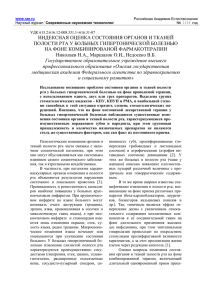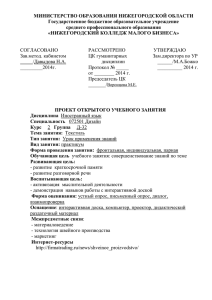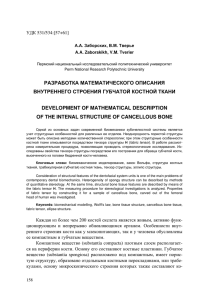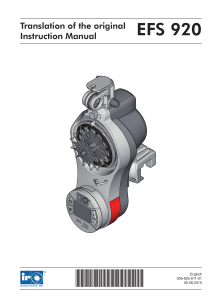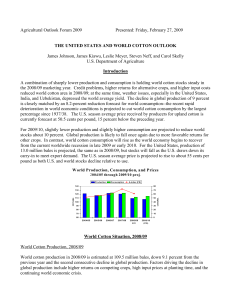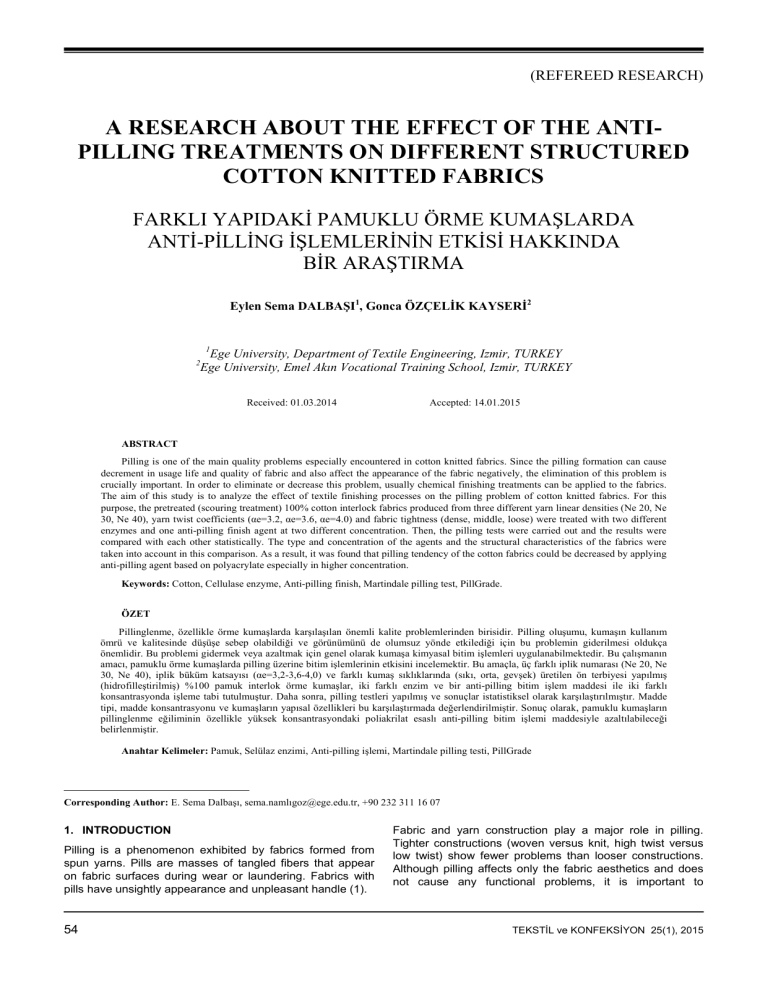
(REFEREED RESEARCH) A RESEARCH ABOUT THE EFFECT OF THE ANTIPILLING TREATMENTS ON DIFFERENT STRUCTURED COTTON KNITTED FABRICS FARKLI YAPIDAKİ PAMUKLU ÖRME KUMAŞLARDA ANTİ-PİLLİNG İŞLEMLERİNİN ETKİSİ HAKKINDA BİR ARAŞTIRMA Eylen Sema DALBAŞI1, Gonca ÖZÇELİK KAYSERİ2 * 1 Ege University, Department of Textile Engineering, Izmir, TURKEY Ege University, Emel Akın Vocational Training School, Izmir, TURKEY 2 Received: 01.03.2014 Accepted: 14.01.2015 ABSTRACT Pilling is one of the main quality problems especially encountered in cotton knitted fabrics. Since the pilling formation can cause decrement in usage life and quality of fabric and also affect the appearance of the fabric negatively, the elimination of this problem is crucially important. In order to eliminate or decrease this problem, usually chemical finishing treatments can be applied to the fabrics. The aim of this study is to analyze the effect of textile finishing processes on the pilling problem of cotton knitted fabrics. For this purpose, the pretreated (scouring treatment) 100% cotton interlock fabrics produced from three different yarn linear densities (Ne 20, Ne 30, Ne 40), yarn twist coefficients (αe=3.2, αe=3.6, αe=4.0) and fabric tightness (dense, middle, loose) were treated with two different enzymes and one anti-pilling finish agent at two different concentration. Then, the pilling tests were carried out and the results were compared with each other statistically. The type and concentration of the agents and the structural characteristics of the fabrics were taken into account in this comparison. As a result, it was found that pilling tendency of the cotton fabrics could be decreased by applying anti-pilling agent based on polyacrylate especially in higher concentration. Keywords: Cotton, Cellulase enzyme, Anti-pilling finish, Martindale pilling test, PillGrade. ÖZET Pillinglenme, özellikle örme kumaşlarda karşılaşılan önemli kalite problemlerinden birisidir. Pilling oluşumu, kumaşın kullanım ömrü ve kalitesinde düşüşe sebep olabildiği ve görünümünü de olumsuz yönde etkilediği için bu problemin giderilmesi oldukça önemlidir. Bu problemi gidermek veya azaltmak için genel olarak kumaşa kimyasal bitim işlemleri uygulanabilmektedir. Bu çalışmanın amacı, pamuklu örme kumaşlarda pilling üzerine bitim işlemlerinin etkisini incelemektir. Bu amaçla, üç farklı iplik numarası (Ne 20, Ne 30, Ne 40), iplik büküm katsayısı (αe=3,2-3,6-4,0) ve farklı kumaş sıklıklarında (sıkı, orta, gevşek) üretilen ön terbiyesi yapılmış (hidrofilleştirilmiş) %100 pamuk interlok örme kumaşlar, iki farklı enzim ve bir anti-pilling bitim işlem maddesi ile iki farklı konsantrasyonda işleme tabi tutulmuştur. Daha sonra, pilling testleri yapılmış ve sonuçlar istatistiksel olarak karşılaştırılmıştır. Madde tipi, madde konsantrasyonu ve kumaşların yapısal özellikleri bu karşılaştırmada değerlendirilmiştir. Sonuç olarak, pamuklu kumaşların pillinglenme eğiliminin özellikle yüksek konsantrasyondaki poliakrilat esaslı anti-pilling bitim işlemi maddesiyle azaltılabileceği belirlenmiştir. Anahtar Kelimeler: Pamuk, Selülaz enzimi, Anti-pilling işlemi, Martindale pilling testi, PillGrade Corresponding Author: E. Sema Dalbaşı, sema.namlı[email protected], +90 232 311 16 07 1. INTRODUCTION Pilling is a phenomenon exhibited by fabrics formed from spun yarns. Pills are masses of tangled fibers that appear on fabric surfaces during wear or laundering. Fabrics with pills have unsightly appearance and unpleasant handle (1). 54 Fabric and yarn construction play a major role in pilling. Tighter constructions (woven versus knit, high twist versus low twist) show fewer problems than looser constructions. Although pilling affects only the fabric aesthetics and does not cause any functional problems, it is important to TEKSTİL ve KONFEKSİYON 25(1), 2015 minimize or prevent pilling in order to maintain customer satisfaction. fabric surface; therefore the pilling tendency of the fabric decreases (6-11). The number of pills on a fabric surface at any time is the result of a dynamic equilibrium between two opposing effects, pill formation and pill wear off. Figure 1 shows the pilling formation schematically. Through abrasion, loose fibers are pulled to the fiber surface and form a layer of ‘fuzz’. The loose fibers are then entangled by the applied abrasion to form pills. As the abrasion continues, the anchor fibers are eventually broken and the pills break off. When the rate of pill formation and the rate of pill break off are equal, an equilibrium state exists (2). Cellulase refers to a family enzymes that act in concert to hydrolyse β-1,4 glucosidic bonds in cellulose. Commercially available cellulases are a mixture of three enzymes, endoglucanases, exoglucanases and cellobiase. Endoglucanases attack cellulose chains randomly along their lengths, acting on the amorphous regions of cellulose. Exoglucanases are thought to act on the crystalline regions of cellulose, attacking the polymer chain ends, generating cellobiose. Cellobiose is further hydrolyzed to glucose by cellobiase. The overall reaction rate is controlled by the hydrolysis products which have an inhibiting effect on the activity of each of these enzymes (12-14). Anti-pilling finish with special chemicals reduces the forming of pills on the knitted fabrics as well. This treatment is based on the use of special agent which aims to suppress the ability of fibers to slacken and also to reduce the mechanical resistance of fiber. Anti-pilling chemical is a liquid acrylic polymer for use as a soft and flexible hand builder. This polymer reduces fraying, pilling and seam slippage of treated fabrics (15). Figure 1. Pilling formation [2] The pilling problem is widely encountered especially in cotton knitted fabrics. Pilling can be prevented or considerably reduced by fiber blends, appropriate yarn and/or fabric construction, suitable finishing or by using lowpilling synthetic fibers (3). In order to eliminate this problem in fabric stage, the antipilling finishing treatments can be applied to the cotton knitted fabrics. Different chemical finishing approaches are made to prevent pills from accumulating on fabric surface such as application of polymers by padding and coating techniques, reduction in the strength of fiber to reduce pilling to cause the pills to fall off from the material as soon as they get formed and application of enzymes (bio finish) to 100% cotton textiles to cause removal of loose fibers in the yarn to reduce pilling tendency (4). The use of enzymes in textile processing dated back to middle of 19th century when malt extract was used to remove amylaceous sizes from some textiles before printing (5). Enzymes are protein molecules capable of catalyzing specific chemical reactions of organic materials. Enzymatic processes have been developed for wet processing of textile goods in wide ranging operations from cleaning preparations to finishing processes (6). Cellulases, hemicellulases and pectinases acting on native cellulosic fibers (cotton, flax, hemp, jute, etc.) have become the target enzymes in the textile bio-processing. Cellulases are commonly used in the textile industry for biostoning and biopolishing of cellulosic fabrics. In bio-polishing process, cellulases remove small loose fiber ends protruding from the fabric surface and improve handle properties. These enzymes are also used to remove the fuzz or pills on the TEKSTİL ve KONFEKSİYON 25(1), 2015 There are several studies about anti-pilling finishing. Tusief et.al optimized the application of different anti-pilling agents at different concentration and pH levels on the tensile strength of Polyester/Cotton blended fabric. The results revealed that various anti pilling agents from different chemical companies with altered compositions showed different levels of activity on fabric tensile strength (16). Bahtiyari et.al investigated the different commercial cellulases in biopolishing of viscose fabrics to decrease pilling tendencies. It was found that the best results were obtained from the use of CBH based cellulase (11). Körlü et.al investigated the influence of cellulase waste on the cellulosic fabrics. Viscose and cotton fabrics were used for trials. The obtained results indicated that cellulose enzymes were more effective for cotton fabrics than viscose ones (17). Mccloskey et.al carried out a study about bio-polishing of 100% polyester woven fabric and 50%/50% polyester/cotton blended knitted fabric. In this study, one commercial cellulase and two different cutinases were used. On both fabrics a significant improvement in pilling prevention was demonstrated (18). Hafiza et.al aimed to produce a cellulose enzyme for bio-polishing of polyester/cotton blended fabric. The bio-polishing results indicated that the cellulose activity was optimum at 55ºC and pH 5.0. the celluse activity/concentration may be varied during bio-polishing for achievşng the desired degree of biopolishing on PES/Cotton fabrics (19). Ciechañska et.al studied on the estimation of the effect of enzymatic treatment on the changes in molecular and morphological structure of viscose woven fabrics. The cellulase enzyme caused the smoothing of the surface of viscose fabric and the removal of impurities and individual loose fiber ends (20). There are several studies on the effects of anti-piling agents. However in these studies, generally the fabrics used were not diversified while the other conditions such as fiber type, chemical type, concentration, pH etc. were changed. Therefore, the importance of this study was to analyze the effects of the enzymes and anti-pilling agent on the cotton knitted fabrics having various structural properties. The 55 fabrics were produced in different yarn linear densities, yarn twist coefficients and fabric tightnesses. Furthermore, the effects of type and the effects of concentration of cellulases and anti-pilling agent have been investigated. 2. MATERIALS AND METHODS Material The fabrics used in the study was cotton knitted interlock in three different yarn linear density (Ne 20, Ne 30 and Ne 40), three different twist coefficients (αe=3.2, αe=3.6 and αe=4.0) and three different fabric tightness (dense: 33.4 course/inch, 27.4 wale/ inch, middle: 28.4 course/ inch, 26.8 wale/ inch, loose: 24.3 course/ inch, 26.6 wale/ inch). In Table 1, the codes of used fabrics in the study are given. Table 1. The codes of the fabrics Yarn linear density (Ne) 3,2 Middle Ne20-αe3.2-M Loose Ne20-αe3.2-L Dense Ne20-αe3.6-D Moreover, one anti-pilling agent based on polyacrylate (A) with two various concentrations was applied to the fabrics by padding method. It was used Rapid Model PA-1 marked laboratory padder for padding method and Ataç GK4 marked laboratory stenter for drying and condensation. The polyacrylate used in this study is a commercial chemical supplied from Bozzetto Group Company. Table 3 shows the all application recipes. The celulases used in the Recipe 1 and Recipe 2 are different. Middle Ne20-αe3.6-M Pilling Test and Assessment Loose Ne20-αe3.6-L Dense Ne20-αe4-D 3,6 3,2 3,6 4,0 3,2 40 For the bio-polishing treatments, two different cellulases (S1-low concentration and S2-high concentration) with two various concentrations (0.5% and 1%) were applied to the pretreated fabrics by exhaustion method in laboratory conditions. The used cellulases were supplied from Indigo Kimya Company. Table 2 indicates the structures of these enzymes. Fabric tightness 4,0 30 Before the anti-pilling treatments, grey cotton fabrics were scoured to remove substances such as wax, pectin, proteins, and hemicelluloses in order to make the fabrics hydrophilic at laboratory conditions in separate tubes. The conventional scouring processes of cotton were conducted at temperatures up to 100°C for 1.5 hours in a very alkaline medium (pH 10-12) with 4 g/l sodium hydroxide (48% solution) and 1 g/l wetting agent. Liquor ratio was 1:10. Twist coefficient (αe ) Dense 20 Method 3,6 4,0 Code Ne20-αe3.2-D Middle Ne20-αe4-M Loose Ne20-αe4-L Dense Ne30-αe3.2-D Middle Ne30-αe3.2-M Loose Ne30-αe3.2-L Dense Ne30-αe3.6-D Middle Ne30-αe3.6-M Loose Ne30-αe3.6-L Dense Ne30-αe4-D Middle Ne30-αe4-M Loose Ne30-αe4-L Dense Ne40-αe3.2-D Middle Ne40-αe3.2-M Loose Ne40-αe3.2-L Dense Ne40-αe3.6-D Middle Ne40-αe3.6-M Loose Ne40-αe3.6-L Dense Ne40-αe4-D Middle Ne40-αe4-M Loose Ne40-αe4-L Before the tests, all fabrics were conditioned under standard atmosphere conditions (20±2°C temperature, 65±4%RH) in the laboratory. The pilling tests of all fabrics were carried out according to EN ISO 12945-2 standard with Martindale instrument by 2000 cycles. After all fabrics were subjected to pilling tests by Martindale instrument, fabric surfaces were evaluated objectively by using PillGrade system. The PillGrade system is an automated pilling grading system developed to provide objective and repeatable pilling assessment in compliance with both ASTM and ISO test methods. After scanning the specimen, detecting and measuring each and every pill in the center area of the specimen, PillGrade uses the PillGrade Grading system from 1.0, which means excessive pilling to 5.0 which means no pilling (21). The pilling grades of all fabrics were evaluated statistically so as to determine the effects of yarn linear density, yarn twist coefficient, fabric tightness, agent type, and agent concentration. For this purpose, first in order to determine whether the variances of each parameters are equal or not, Levene`s homogeneity test was carried out and according to the result of this test, multiple variance analysis (ANOVA) and for comparison of each levels of the investigated factors with each other, multiple comparison test (Tamhane or SNK) were done. Table 2. Enzymes used in bio-polishing Enzyme Structure S1 Endo enriched acidic cellulase 90.6 kCMU/g 8% S2 Endo enriched acidic cellulase 90.6 kCMU/g 12 % 56 Enzyme Activity Enzyme Concentration TEKSTİL ve KONFEKSİYON 25(1), 2015 Table 3. The application recipes and codes for anti-pilling treatments Recipe 1 Recipe 2 METHOD 1 Enzyme type Enzyme concentration pH (with acetic acid) Method Process temperature Process time Liquor ratio Recipe 3 Codes METHOD 2 Codes S1-1 Cellulase 1 S2-1 Cellulase 2 S1-2 Cellulase 1 S2-2 Cellulase 2 0.5% 1% 0.5% 1% 4.5 4.5 4.5 4.5 Exhaustion Exhaustion Exhaustion Exhaustion Chemical type Chemical concentration pH (with acetic acid) Method 55°C 55°C 55°C 55°C 60 min. 1/20 60 min. 1/20 60 min. 1/20 60 min. 1/20 A1 Polyacrylate A2 Polyacrylate 20 g/l 60 g/l 5 5 Padding Padding Pick up value 75% 75% Drying+condensation temperature and time 130°C for 3 min. 130°C for 3 min. 3. RESULTS AND DISCUSSION 5 Pilling evaluation 4 Pilling Grade Figure 2, Figure 3 and Figure 4 indicate the pilling grades of the untreated and treated fabric samples produced from yarns in Ne 20 yarn linear density. As can be seen, after the anti-pilling treatments nearly 1-2 pilling grades of improvement were achieved. Not only the cellulase enzymes but also the polyacrylate were effective, however the performance of polyacrylate was better at tested concentrations. With the increment in the agent concentration and the fabric tightness, the tendency of pilling decreased. In loose fabrics, due to the simplified movement of the fibers towards to the fabric surface, the pilling propensity increases. Generally with the changing of yarn twist coefficient, it cannot be seen obvious differences between the pilling grades of all fabric samples. 3 2 1 0 Untreated S1‐1 S1‐2 Ne20‐αe4‐D S2‐1 S2‐2 Ne20‐αe4‐M A1‐1 A1‐2 Ne20‐αe4‐L Figure 4. The pilling values of the samples with αe= 4 Figure 5, Figure 6 and Figure 7 indicate the pilling values of the untreated and treated samples produced from yarns in Ne 30 yarn linear density. 5 5 4 3 Pilling Grade Pilling Grade 4 2 1 3 2 1 0 Untreated S1‐1 S1‐2 S2‐1 S2‐2 A1‐1 A1‐2 0 Untreated Ne20‐αe3.2‐D Ne20‐αe3.2‐M S1‐1 S1‐2 S2‐1 S2‐2 A1‐1 A1‐2 Ne20‐αe3.2‐L Ne30‐αe3.2‐D Ne30‐αe3.2‐M Ne30‐αe3.2‐L Figure 2. The pilling values of the samples with αe=3.2 Figure 5. The pilling values of the samples with αe=3.2 5 5 4 Pilling Grade Pilling Grade 4 3 2 1 3 2 1 0 0 Untreated S1‐1 Ne20‐αe3.6‐D S1‐2 S2‐1 Ne20‐αe3.6‐M S2‐2 A1‐1 A1‐2 Ne20‐αe3.6‐L Figure 3. The pilling values of the samples with αe= 3.6 TEKSTİL ve KONFEKSİYON 25(1), 2015 Untreated S1‐1 Ne30‐αe3.6‐D S1‐2 S2‐1 Ne30‐αe3.6‐M S2‐2 A1‐1 A1‐2 Ne30‐αe3.6‐L Figure 6. The pilling values of the samples with αe= 3.6 57 5 5 4 Pilling Grade Pilling Grade 4 3 2 1 3 2 1 0 Untreated S1‐1 S1‐2 S2‐1 S2‐2 A1‐1 A1‐2 0 Untreated S1‐1 S1‐2 Ne30‐αe4‐D S2‐1 S2‐2 Ne30‐αe4‐M A1‐1 A1‐2 Ne30‐αe4‐L Ne40‐αe4‐M Ne40‐αe4‐L Figure 10. The pilling values of the samples with αe= 4 Figure 7. The pilling values of the samples with αe= 4 In the fabrics produced from yarns in Ne 30 yarn linear density, after the anti-pilling treatments the pilling grades increased approximately between 1 and 1.5 grades. The performance of polyacrylate was better than that of cellulases’ at tested concentrations. The effect of agent concentration was also noticeable. As the fabric tightness increased, the tendency of pilling formation decreased. However the effect of yarn twist coefficient was not seen apparently. When compared with the fabrics in Ne 20 yarn linear density, the pilling degrees were generally lower. Figure 8, 9 and 10 indicate the pilling values of the untreated and treated samples produced from yarns in Ne 40 yarn linear density. 5 4 Pilling Grade Ne40‐αe4‐D As the figures given for the fabrics in Ne 40 yarn linear density are evaluated, it can be seen that the pilling formation is in high tendency for all samples. After the antipilling treatments the pilling grades increased approximately between 1 and 3 grades. The performance of polyacrylate was better compared to cellulases at tested concentrations. The effect of agent concentration was apparent. As the fabric tightness increased especially for dense fabric samples, the tendency of pilling decreased however the effect of yarn twist coefficient was not clear. When compared with the fabrics in Ne 20 and Ne 30 yarn linear densities, the pilling degrees of fabrics in Ne 40 were generally lowest. As the yarn gets finer, the pilling degree decreases. The structures of the pills change according to the yarn fineness. In fabrics produced from coarser yarns, the size of the pills are bigger than the pills in fabrics produced with finer yarn but since the number of medium and small pills are higher in fabrics with finer yarns, the pilling grades become worse. In order to determine the enhancement in pilling degrees that the anti-pilling agents were supplied, the differences between the pilling grades of untreated and treated samples were examined. Figure 11 demonstrates the average improvement values in pilling grades of fabrics treated with three different anti-pilling agents. 3 2 1 0 Untreated S1‐1 S1‐2 S2‐1 S2‐2 A1‐1 A1‐2 5 Ne40‐αe3.2‐D Ne40‐αe3.2‐M Ne40‐αe3.2‐L Figure 8. The pilling values of the samples with αe= 3.2 Pilling grade 4 3 2 1 5 0 Pilling Grade 4 3 S1‐2 S2‐1 S2‐2 A1‐1 A1‐2 0,67 0,81 0,74 1,29 1,61 1,48 Ne 30 0,27 0,26 0,68 1,10 1,50 1,72 Ne 40 0,17 0,52 0,60 1,09 1,53 1,81 2 Figure 11. The average improvement values in the degree of pilling of fabrics 1 0 Untreated S1‐1 S1‐2 Ne40‐αe3.6‐D S2‐1 S2‐2 Ne40‐αe3.6‐M A1‐1 A1‐2 Ne40‐αe3.6‐L Figure 9. The pilling values of the samples with αe= 3.6 58 S1‐1 Ne 20 Among the agents, the most effective one was found as polyacrylate by enhancing the pilling degrees of the fabrics between 1.5-1.81 grades at tested concentrations. Because of the polyacrylates, the movements of fibers are limited. So, fibers cannot be protruded from the yarns and the pilling tendency of fibers reduces (22). When compared the TEKSTİL ve KONFEKSİYON 25(1), 2015 enzymes with each other, S2 cellulase enzyme was better and maximum grade 1.29 was enhanced. The effect of the agent concentration was apparent in all the agents. Since there are more fuzzes on the surface of the fabrics in Ne 20 and the enzymes also perform on the surface of the fabrics, the improvement in pilling degrees of the fabrics in Ne 20 were better than the fabrics in Ne 30 and Ne 40. However the usage of polyacrylate in high concentration (60 g/l) for fabrics in Ne 40 resulted in better improvement in pilling degrees. mentioned before, the mean differences between the values of fabrics in different twist coefficients were not statistically significant, as the values were quite close to zero. The effect of fabric tightness was found statistically important; however this result was probably due to the difference between the dense and other fabrics. Because the difference between the mean values of medium and loose fabrics was 0.1562 and not statistically significant. Statistical evaluation Pills are an aesthetic and physical nuisance because the surface appearance of a textile material is very important for consumers. Therefore pilling propensity of the fabrics is tried to be controlled and reduced by various anti-finishing processes which are very effective and preferred methods. According to the variance homogeneity test, which was carried out for determining whether the variances of the groups were equal or not, the differences between the variances of the groups were found statistically significant (p=0.000). Therefore, for comparison of all levels of the investigated parameters, Tamhane multiple comparison test was carried out, as given in Table 4. As seen from Table 4, the differences between the mean pilling degree values of the fabrics in all factor levels were found statistically significant except the yarn twist coefficients and fabric tightness between the medium and loose fabrics. The mean differences in pilling degrees of untreated and anti-pilling agents also confirmed that the most effective agent was polyacrylate. The average pilling degrees of the agents treated with low concentration was 0.2522 degree lower than the mean values of the fabrics treated with high concentration. The result of the comparison done in terms of yarn linear density showed that the fabrics produced from coarser yarns had better pilling degree. The difference of the mean values between the fabrics in Ne 30 and Ne 40 is 0.2362 degree. As also 4. CONCLUSION In this study, examine the the interlock yarn linear tightness. three kinds of anti-pilling agents were used to pilling enhancement effects of the agents on knitted fabrics produced from three different density, yarn twist coefficient and fabric According to the results, it was found that pilling tendency of the cotton fabrics could be decreased by applying antipilling agent based on polyacrylate especially in higher concentration. Whereas the pilling degree of the fabrics treated with cellulases was increased approximately 0.5-1 degree, the pilling degree of the fabrics treated with polyacrylate was increased 1.5 degree. The increase of the agent concentration caused the lower pilling tendency. Moreover, in terms of structural properties of the fabric, the denser the fabric and the thicker the yarn provided the lower pilling tendency. However the effect of yarn twist coefficient was not seen apparently on the pilling propensity of the fabrics. Table 4. The multiple comparison results Anti-pilling treatment S1- Untreated S2-Untreated A- Untreated S1-S2 S1-A S2-A Mean difference 0.4219 0.8957 1.5885 -0.4738 -1.1667 -0.6928 Sig.(p) 0.000* 0.000* 0.000* 0.000* 0.000* 0.000* Agent concentration Concentration 1- Concentration 2 Mean difference -0.2522 Sig.(p) 0.002* Yarn linear density Ne20-Ne 30 Ne 20-Ne 40 Ne 30-Ne 40 Mean difference 1.0527 1.2889 0.2363 Sig.(p) 0.000* 0.000* 0.002* αe=3.2 - αe=3.6 αe=3.2 - αe=4.0 αe=3.6 - αe=4.0 -0.0430 -0.1844 -0.1414 0.938 0.083 0.264 Dense-Medium Dense-Loose Medium-Loose Mean difference 0.6151 0.7712 0.1562 Sig.(p) 0.000* 0.000* 0.118 Yarn twist coefficient Mean difference Sig.(p) Fabric tightness *The mean difference is significant at the 0.05 level TEKSTİL ve KONFEKSİYON 25(1), 2015 59 REFERENCES 1. Periyasamy, A.P. and Prince, D.B., 2012, “Effect of Fibrillation on Pilling Tendency of Lyocell Fiber”, Indian Textile Journal, Vol.122, No.10, pp:49-54. 2. Schindler, W.D. and Hauser, P.J., 2004, “Anti-Pilling Finishes, Chemical Finishing of Textiles”, Woodhead Publishing Ltd, Cambridge, pp:129-137. 3. Krishnaveni, V., 2011, “Pilling Identification & Steps for Reduction”, The Indian Textile Journal, Vol.121, No.10, pp:80-82. 4. Goyal, R. and Prabhu C.N., 2008, “Anti-Pilling Solutions”, Colourage, Vol.55, No.9, pp:95-97. 5. Aly, A.S., Moustafa, A.B., Hebeish, A., 2004, “Bio-Technological Treatment of Cellulosic Textiles”, Journal of Cleaner Production, Vol.12, No.7, pp:697–705. 6. Csiszar, E., Urbanszki, K., Szakacs, G., 2001, “Biotreatment of Desized Cotton Fabric by Commercial Cellulase and Xylanase Enzymes”, Journal of Molecular Catalysis B: Enzymatic, Vol.11, No.4, pp:1065–1072. 7. Horn, S.J., Kolstad, G.V., Westereng, B., Eijsink, V., 2012, “Novel enzymes for the degradation of cellulose”, Biotechnology for Biofuels, Vol.5, No.45, pp:112. 8. Oinonen, A.M., Londesborough, J., Joutsjoki, V., Lantto, R., Vehmaanperä, J., Primalco Ltd. Biotec, 2004, “Three Cellulases from Melanocarpus Albomyces for Textile Treatment at Neutral pH”, Enzyme and Microbial Technology, Vol.34, No. 3-4, pp:332–341. 9. Carrillo, F., Colom, X., Lopez-Mesas, M., Lis, M.J., Gonzalez, F., Valldeperas, J., 2003, “Cellulase Processing of Lyocell and Viscose Type Fibres: Kinetics Parameters”, Process Biochemistry Vol.39, pp:257-261. 10. Csiszar, E., Losonczi, A., Szakacs, G., Rusznak, I., Bezur, L., Reicher, J., 2001, “Enzymes and Chelating Agent In Cotton Pretreatment”, Journal of Biotechnology, Vol.89, No.2-3, pp:271–279. 11. Bahtiyari, M.İ., Duran, K., Körlü, A., Perinçek, S., 2010, “Usage of Commercial Cellulases In Biopolishing of Viscose Fabrics”, Tekstil ve Konfeksiyon, No.1, pp:57-64. 12. Zhang, J., 2006, “Biochemical Study and Technical Applications of Fungal Pectinase”, Faculty of Science and Technology, Uppsala University, PhD thesis, pp:1-42. 13. Diller, G.B., Walsh, W.K., Radhakrishnaiah, P., 1999, “Effect of Enzymatic Treatment on Dyeing and Finishing of Cellulosic Fibers: A Study of the Basic Mechanisms and Optimization of the Process”, National Textile Center Annual Report: November 1999, C96-A01, pp:1-9. 14. Kanchagar, A.P., 2003, “Adsorption of Purified Cellulases on Cotton Fibers", Thesis of Doctor of Philosophy, Athens, Georgia, 2003, pp:1-3. 15. http://en.texsite.info (Access date: Sep 2014). 16. Tusief, M.Q., Mahmood, N., Amin, N., Saleem, M., 2013, “Fabric Tensile Strength as Affected by Different Anti pilling Agents at Various Concentration and pH Levels”, J.Chem.Soc.Pak., Vol.35, No.2, pp:238-242. 17. Körlü, A.E., Duran, K., Bahtiyari, M.İ., Perinçek, S., 2008, “The Effects Of Cellulase Enzymes On Cellulosic Fabrics”, Tekstil ve Konfeksiyon, Vol.18, No.1, pp:35-41. 18. Mccloskey, S.G., Jump, J.M., 2005, “Bio-Polishing of Polyester and Polyester/Cotton Fabric”, Textile Research Journal, Vol.75, pp:480-484. 19. Hafiza, N., Muhammed, A.Z., Shaukat, A., Tanveer, H., 2014, “Optimization of bio-polishing of polyester/cotton blended fabrics with cellulases prepared from Aspergillus niger”, Indian Journal of Biotechnology, Vol.13, pp:108-113. 20. Ciechañska, D., Struszczyk, H., Miettinen-Oinonen, A., Strobin, G., 2002, “Enzymatic Treatment of Viscose Fibres Based Woven Fabric”, Fibres & Textiles in Eastern Europe, Vol. 10, No.4, pp:60- 63. 21. PillGrade Automated 3D Pilling & Fuzz Grade System- Operation Manual, SDL Atlas, Line Tech Industries, Inc., 2008. 22. Wahle, B., Falkowski, J., 2002, “Softeners in Textile Processing Part I: An overview", Review of Progress in Coloration and Related Topics, Vol. 32, Issue 1, pp:118-124. 60 TEKSTİL ve KONFEKSİYON 25(1), 2015
